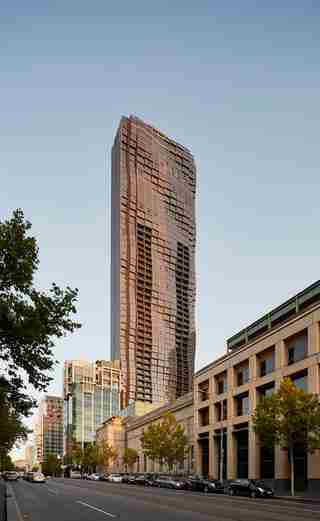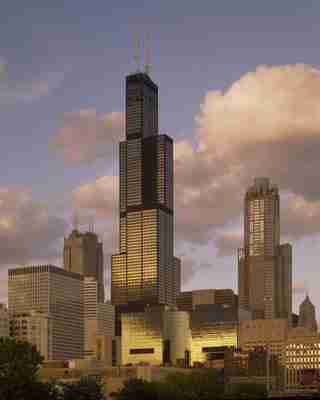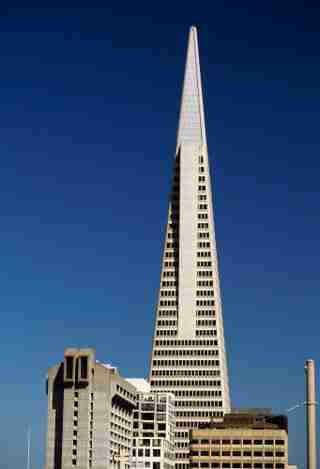In many ways, the race to the sky, the need to build taller, is as old as time. Yet it's over the past century that we've seen a significant leap in the total height of our tallest skyscrapers (by define, a skyscraper is a building that exceeds 330 feet). But that doesn't mean they've always been beautiful creations . Designers are constantly looking to reinvent the modern skyscraper with higher, more cutting-edge designs. From the Art Deco movement at the beginning of the 20th century to more modern, neo-futuristic style, each building embodies the evolution of urban architecture. Ultimately, any city’s skyline tells a distinct story of innovation and ambition, and these 27 stunning structures are no exception.

Abode318 (Melbourne, Australia)
The unique wave-like design of Abode318 is more than just an aesthetic design choice, it creates insulation for the residential building. Designed by Elenberg Fraser and Disegno Australia, the structure contains 450 apartments with some of the best views in Melbourne.

Willis Tower (Chicago, Illinois)
Completed in 1973, the Willis Tower has long been the most iconic piece of Chicago’s storied skyline. Formerly dubbed the Sears Tower, the black lacquered structure has one of the tallest observation decks in the Western Hemisphere.

Transamerica Pyramid (San Francisco, California)
The futurist building that fills out San Francisco’s skyline was built in 1972 and has become symbolic of the Golden City. William Pereira designed the landmark and placed a “Crown Jewel” at its peak which illuminates on holidays and days of remembrance.
Al Hamra Tower (Kuwait City, Kuwait)
Al Hamra Tower is a multimedium building that gives the illusion of movement, as if in mid-transition of being cocooned into a sheet of glass. Crafted by the firms Skidmore, Owings & Merrill and Ramshir and Callison, the structure stands an impressive 1,358 feet tall.
432 Park Avenue (New York, New York)
Standing an impressive 1,396 feet tall, 432 Park Avenue is the tallest completed residential building in the Western Hemisphere. Designed by Rafael Viñoly, the blocklike tower is dotted in symmetrical squares and lights in a specific pattern upon nightfall to add to the New York skyline.
Marina Bay Sands Hotel (Singapore)
The Marina Bay Sands Hotel is one of the most recognizable buildings in Singapore, if not the world. Designed by Moshe Safdie, the three-column building is connected at the roof by the largest rooftop infinity pool.
Evolution Tower (Moscow, Russia)
The spiraling design of Evolution Tower was created by British architect Tony Kettle and was inspired by Rodin’s sculpture The Kiss.
Agbar Tower (Barcelona, Spain)
Agbar Tower’s bullet-shaped construction is coated in a mosaic of glass that calls to Barcelona’s architectural roots laid by Antoni Gaudi. Brought to life by French architect Jean Nouvel, the building was not well received at first but eventually became a celebrated piece of that Catalan city.
Tokyo Skytree (Tokyo, Japan)
Designed by Nikken Sekkei, the neofuturistic broadcast tower came into the city skyline in 2012. Styled like a Japanese pagoda, Tokyo Skytree draws tourists in droves to the spectacular observation deck. The “skytree white” lattice that coats the exterior is a perfect foundation for the tower’s nightly light show.
Shanghai World Finance Center (Shanghai, China)
Designed by Kohn Pedersen Fox, the Shanghai World Finance Center’s (on right) slightly curved trapezoid design with a rectangular gap was completed in 2008.
Abraj Al-Bait Tower (Mecca, Saudi Arabia)
As part of a seven-building complex, the four-faced clock tower overlooks the sacred Great Mosque of Mecca. Its neoclassical-inspired beauty aside, the tower, which is also a hotel, has become a beacon for worshippers wishing to make their pilgrimage to Mecca. It was designed by the German firm SL Rasch.
John Hancock Center (Chicago, Illinois)
The iconic ebony building with twin antennae is corseted with matte structural beams creating a geometric design. Designed by Skidmore, Owings & Merrill, and located in Chicago’s Magnificent Mile district, the tapered structure has become a beloved part of the city’s skyline.
Turning Torso (Malmö, Sweden)
The neofuturistic residential skyscraper Turning Torso reaches much higher than the surrounding buildings in the area. Each floor is an irregular pentagon shape that shifts with every story. The highest floor is twisted 90 degrees from the ground level. Designed by Santiago Calatrava, the inspiration for the building’s unique shape came from the sculpture of a twisted human midsection.
Taipei 101 (Taipei, Taiwan)
Similar to the style of the Jin Mao Tower, Taipei 101 is rooted in traditional Chinese architecture. Completed in 2010 and designed by Chu-Yuan Lee and C.P. Wang, the 101 stories are numerically symbolic of time starting over in the new decade and the new year.
Canton Tower (Guangzhou, China)
Designed by Mark Hemel and Barbara Kuit, as well as the Arup team, Canton Tower is the ultimate sightseeing experience, boasting the world’s tallest open-air staircase, in which guests can physically ascend the tower. The structure’s climbing lattice–like exterior twists upward, giving the tower the appearance of a “slim waist."
Petronas Twin Towers (Kuala Lumpur, Malaysia)
Standing at 88 stories high, the numeral eight theme used throughout the building is symbolic of good fortune. The two towers, which were designed by the late César Pelli , connected by a flying bridge are grounded in Islamic architecture. Because of the soft ground on which the towers were built, the foundations reach up to 374 feet deep to support the structures.
Space Needle (Seattle, Washington)
Seattle’s tallest and most recognizable structure was erected as a result of two ideas conceived for the city's 1962 World’s Fair. One concept was inspired by a tethered balloon and another by a flying saucer–type design. Together, these two ideas presented by Edward E. Carlson and John Graham Jr. were combined to create the Washington state landmark.
Oriental Pearl Tower (Shanghai, China)
Oriental Pearl Tower is held together by 11 spheres of different sizes attached by columns. Though the structure’s design is likened to an old Chinese proverb, designer Jiang Huancheng insists it is a coincidence.
CN Tower (Toronto, Ontario)
In addition to its recognizable needlelike design, CN Tower’s EdgeWalk is a bucket list item for many avid travelers. Designed by Australian architect John Andrews, the record-breaking tower was finished in 1976 and held the record for tallest structure in the world until 2007.
Burj Al Arab Jumeirah (Dubai, United Arab Emirates)
Situated on a small artificial island, the sail-shaped luxury hotel looks as though it’s coming into port at Jumeirah Beach. The structure was designed by British-born architect Tom Wright.
Jin Mao Tower (Shanghai, China)
The architects at SOM were inspired by traditional Chinese architecture when creating the postmodern Jin Mao Tower. The result has become one of the most recognizable structures in Shanghai’s financial district. Standing 1,380 feet tall, the building was one of the first to use new advanced structural engineering that could withstand typhoon winds as well as earthquakes ranging up to a seven on the Richter scale.
The Shard (London, England)
Italian architect Renzo Piano was inspired by the railroad lines of downtown London and church spires when creating this building. Piano’s objective was to create a structure that looked as though it was emerging from the River Thames.
Shanghai Tower (Shanghai, China)
The 128-story tower’s tiered exterior was designed to be energy efficient with aspects that include a double layer of glass to reduce heat absorption. Gensler's Shanghai Tower earned the title of “greenest skyscraper” for its efforts.
Burj Khalifa (Dubai, United Arab Emirates)
Standing at 2,722 feet tall, Burj Khalifa is currently the tallest building in the world. Designed by Skidmore, Owings & Merrill, the architects drew inspiration from Islamic architecture, specifically the Great Mosque of Samarra.
Empire State Building (New York, New York)
The Empire State Building is one of the most recognizable structures in New York. Designed by Shreve, Lamb & Harmon, the skyscraper's design was changed 15 times until it was assured to be the tallest in the world at the time.
Chrysler Building (New York, New York)
This Art Deco masterpiece is a shining example of architecture in the industrial age. Designed by famed architect William Van Alen, there are numerous references to Chrysler’s storied history with gargoyles resembling car parts and geometric eagles said to signify flight.
One World Trade Center (New York, New York)
Standing an iconic 1,776 feet tall, a nod to the year of American independence, One World Trade Center joined the New York skyline in 2014. The mirrored building holds a special meaning to Americans, signifying resilience and strength. Designed by Skidmore, Owings & Merrill, One World Trade Center is the tallest building in the Western Hemisphere.
